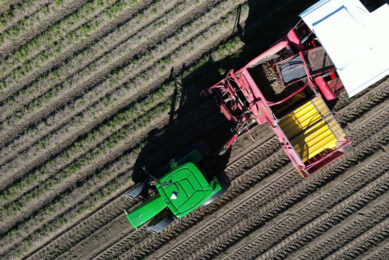Precisely reading plant status to get actionable insights

New Zealand company Croptide has developed a novel sensor to precisely read plant status directly from the stem of plants. “It’s a matter of understanding exactly what the plant needs”, Co-Founder and CEO Hamish Penny says.
The Croptide sensor is designed for permanent crops, such as fruit and tree crops. With this ‘smartwatch’ for plants, growers get actionable insights to help them make more effective decisions, Penny says.
Croptide’s technology maximises crop yield, improves fruit quality, reduces water waste by up to 50%, and delivers better financial and environmental outcomes, according to Penny. “We have seen farmers saving up to half the water they have been using. The connection between effective irrigation and its benefits is well-known.”
Measuring the water status
Penny got the idea for the sensor when he was working in Hawke’s Bay, doing a Masters Project after finishing an engineering degree. “I came across the measurement technique that we use, and I was fortunate enough to meet a few local growers. They told me that, if we could measure the water status of plants, it would be really helpful. Very quickly, we got some initial test equipment out onto some commercial blocks, measuring plants.”
Penny emphasises that Croptide sensors gather a lot of information from plants. “We have signals that are related to nutrient status, and to different aspects of water status. We see a different response when plants are diseased or not diseased. We can see physiological changes. But a lot of that is still in development, and we are trying to understand how we can help growers to use it.”

Fruit and tree crops
The Croptide sensor is currently designed for permanent crops, such as fruit and tree crops. “It is possible that it could be adapted for other types of crops in the future, but there are a lot of opportunities – and problems to solve – in these initial industries. That’s where our focus is at the moment.”
Croptide’s priority so far has been to accurately measure the water status of plants. “At the moment, we can see the transpiration of the plants. When they start to enter into stress, we can see that. And we have been working on stem water potential measurement, using our device as well, which basically tells you how accessible water is for the plant.”
You can see how the plant is responding with excessive rainfall for example
The information also gives growers the opportunity to respond to extreme weather, Penny says. “You can see how the plant is responding with excessive rainfall for example. Is the plant under stress or is it still happy? How long does it take for the soil to dry out? And when it is very dry, you can see when and how the plant is entering stress, so you can apply irrigation as needed. You can take best advantage of the available water. In both cases, it is useful to have the feedback of how well the plant is responding to the extreme weather event.”
Simplifying operations
The number of sensors that are used, hinges on a few factors, Penny explains. “The soil or the crop for example. These operations are generally broken up into operation blocks, where there is a certain area where they can turn the tap on or off. We just pick a number of plants that give us an accurate representation of that block of land, usually eight plants per block.”
The technology can also help growers save on time and labour costs, Penny says. “It’s definitely a key focus for us to simplify the operations, and reduce the time it takes to make decisions. To provide operational transparency. And there is the possibility to automate our system. Operational efficiency is a key part of how we want to help our customers.”
The Croptide technology is already commercially available in New Zealand
The Croptide technology is already commercially available in New Zealand. The company plans to launch it in other countries in due course. “There are opportunities in the US, Italy, France and Australia for example. Those countries would be the obvious next steps.”
Penny believes that environmental and economic drivers are going to accelerate the move to precision farming. “There is a need for growers to understand how better make use of resources. And there is a wider importance of sustainability.”
Join 17,000+ subscribers
Subscribe to our newsletter to stay updated about all the need-to-know content in the agricultural sector, two times a week.



